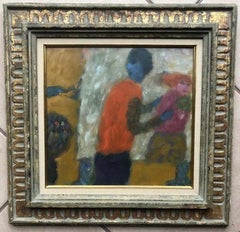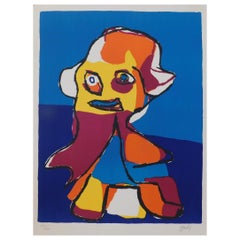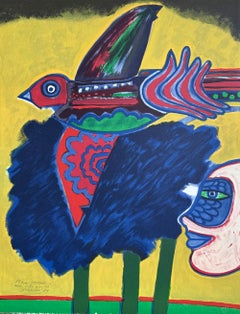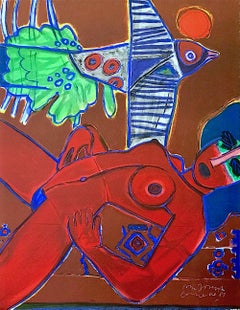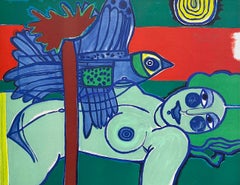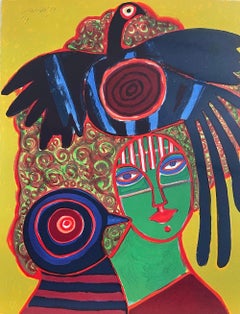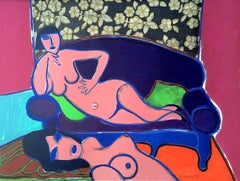Eugene Brands
1950s Figurative Paintings
Oil
1960s Abstract Prints
Paper
1980s Expressionist Landscape Prints
Lithograph
1980s Expressionist Figurative Prints
Lithograph
1980s Expressionist Nude Prints
Lithograph
1980s Contemporary Figurative Prints
Lithograph
1980s Expressionist Nude Prints
Lithograph
1970s Contemporary Nude Prints
Lithograph
Late 20th Century Modern Animal Prints
Lithograph
1970s Abstract Expressionist Abstract Drawings and Watercolors
Paper, Gouache
1950s Abstract Expressionist Portrait Paintings
Paper, Oil
1980s Abstract Expressionist Abstract Drawings and Watercolors
Paper, Gouache
1960s Abstract Expressionist Landscape Drawings and Watercolors
Paper, Gouache
1980s Abstract Expressionist Landscape Drawings and Watercolors
Paper, Gouache
1960s Expressionist Landscape Drawings and Watercolors
Paper, Watercolor
1970s Abstract Expressionist Abstract Drawings and Watercolors
Gouache, Archival Paper
1980s Abstract Expressionist Abstract Drawings and Watercolors
Gouache, Archival Paper
1970s Expressionist Figurative Prints
Watercolor, Black and White, Lithograph, Paper
1980s Contemporary Figurative Prints
Lithograph
20th Century Abstract Abstract Paintings
Watercolor
20th Century Abstract Abstract Paintings
Watercolor
20th Century Abstract Abstract Paintings
Oil
Eugene Brands For Sale on 1stDibs
How Much are Eugene Brands?
A Close Look at Post-impressionist Art
In the revolutionary wake of Impressionism, artists like Vincent van Gogh, Georges Seurat, Paul Cézanne and Paul Gauguin advanced the style further while firmly rejecting its limitations. Although the artists now associated with Postimpressionist art did not work as part of a group, they collectively employed an approach to expressing moments in time that was even more abstract than that of the Impressionists, and they shared an interest in moving away from naturalistic depictions to more subjective uses of vivid colors and light in their paintings.
The eighth and final Impressionist exhibition was held in Paris in 1886, and Postimpressionism — also spelled Post-Impressionism — is usually dated between then and 1905. The term “Postimpressionism” was coined by British curator and art critic Roger Fry in 1910 at the “Manet and the Postimpressionists” exhibition in London that connected their practices to the pioneering modernist art of Édouard Manet. Many Postimpressionist artists — most of whom lived in France — utilized thickly applied, vibrant pigments that emphasized the brushstrokes on the canvas.
The Postimpressionist movement’s iconic works of art include van Gogh’s The Starry Night (1889) and Seurat’s A Sunday on La Grande Jatte (1884). Seurat’s approach reflected the experimental spirit of Postimpressionism, as he used Pointillist dots of color that were mixed by the eye of the viewer rather than the hand of the artist. Van Gogh, meanwhile, often based his paintings on observation, yet instilled them with an emotional and personal perspective in which colors and forms did not mirror reality. Alongside Mary Cassatt, Cézanne, Henri Matisse and Gauguin, the Dutch painter was a pupil of Camille Pissarro, the groundbreaking Impressionist artist who boldly organized the first independent painting exhibitions in late-19th-century Paris.
The boundary-expanding work of the Postimpressionist painters, which focused on real-life subject matter and featured a prioritization of geometric forms, would inspire the Nabis, German Expressionism, Cubism and other modern art movements to continue to explore abstraction and challenge expectations for art.
Find a collection of original Postimpressionist paintings, mixed media, prints and other art on 1stDibs.
Finding the Right Figurative-prints-works-on-paper for You
Bring energy and an array of welcome colors and textures into your space by decorating with figurative fine-art prints and works on paper.
Figurative art stands in contrast to abstract art, which is more expressive than representational. The oldest-known work of figurative art is a figurative painting — specifically, a rock painting of an animal made over 40,000 years ago in Borneo. This remnant of a remote past has long faded, but its depiction of a cattle-like creature in elegant ocher markings endures.
Since then, figurative art has evolved significantly as it continues to represent the world, including a breadth of works on paper, including printmaking. This includes woodcuts, which are a type of relief print with perennial popularity among collectors. The artist carves into a block and applies ink to the raised surface, which is then pressed onto paper. There are also planographic prints, which use metal plates, stones or other flat surfaces as their base. The artist will often draw on the surface with grease crayon and then apply ink to those markings. Lithographs are a common version of planographic prints.
Figurative art printmaking was especially popular during the height of the Pop art movement, and this kind of work can be seen in artist Andy Warhol’s extensive use of photographic silkscreen printing. Everyday objects, logos and scenes were given a unique twist, whether in the style of a comic strip or in the use of neon colors.
Explore an impressive collection of figurative art prints for sale on 1stDibs and read about how to arrange your wall art.
